Winemaker Olivier Dauga’s clothes make a statement and so do his wines. Convivial, colorful and energetic, Olivier Dauga is one of those winemakers who possesses extensive wine knowledge not only about his native region of Bordeaux but all around the world. He also shares this knowledge freely and without condescension.
As an individual he is probably a “team player” ( if his years in professional rugby are any indication). But as a winemaker, he is seldom one to go with the crowd, and make wines that only reflect the style and composition of a particular region. Instead Olivier Dauga takes chances.
He plants the best varietals for each area depending on the soil and climate, hand harvests only the best yields and creates wines using production methods that require the least amount of artificial manipulation and additives. His approach to a style of a wine might vary depending on the merits of each harvest in any particular year but his wine making philosophy remains the same.
Olivier Dauga believes wine production should involve natural methods whenever possible. Mechanical processing and artificial ingredients should be minimal. In addition, the “fruit” in the grape should be reflected in the wine. Mostly importantly, the winemaking methods should not harm or interfere with the well being of the environment.
Olivier Dauga partners with winemakers from different regions around the world and helps them make wines that reflect the best of what their lands can yield. He also takes into account the type of wine that will express the winemaker’s style and approach. The wines he produces in collaboration with the winemaker are not “sanitized,” or produced according to strict and established guidelines. Nor are they wines that have been processed or manipulated until they adhere to what everyone has come to expect from a particular varietal and region based on precedence.
Instead Olivier Dauga works with winemakers to produce wines that are unique, bold, and full of vibrancy, fruit and complexity on the palate. His portfolio includes a range or sparkling, whites, reds and rosés from France, Australia and other Old and New World regions.
A selection was presented on June 13, 2016 at Cocotte Restaurant in New York City. A rose’, a white and a selection of reds were paired with Basque Country accented, Southwestern French cuisine.

A balanced Chateau de Jonquieres, Cuvee Cersius, 2015 rose’ from Languedoc, comprised of 60% Grenache and 40% Cinsault, with delicate floral aromas and fresh raspberry notes, was presented on arrival. It was perfect for the spring afternoon.
A Domaine de Cazelles Verdier, Les Pierres Qui Chantent, I.G.P., 2015 Chardonnay from the Pays d Oc, complemented an amuse bouche duo of foie gras creme brulee and champignons farcis (stuffed cremini mushrooms with chorizo and garlic cream). This vintage had tropical fruit, toast and roasted nut aromas, subtle oak and white peach, citrus fruit and vanilla cream notes. The balanced acidity of the rose’ and the citrus fruit elements of the chardonnay cut through the richness of the foie gras and added an element of zest to the mushrooms.
A charcuterie board (a selection of cured meats, green chilies and tomato bread) followed. This course was paired with a well rounded Chateau Fleur Haut Gaussens, La Viminiere, A.O.P. Bordeaux Superieur, 2015 comprised of 100% Malbec, from Fronsac in Bordeaux. It was full of sweet blackberry and blueberry, and slightly earthy aromas, ripe berry and pepper notes, and a smooth and lingering finish.

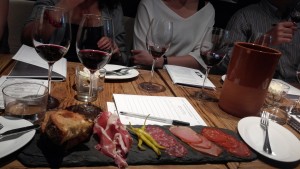
A tender chicken paillard course was served with an elegant Chateau Notre Dame du Quatourze, a Fleur d Eau, 2014 blend of Syrah, Grenache, Mourvedre and Carignan from Languedoc. This wine had lovely violet, ripe raspberry and coffee aromas, lush berry and sweet spice notes and a lingering velvety finish. This blend enhanced the subtly savory flavors of the chicken paillard and added elements of spice.
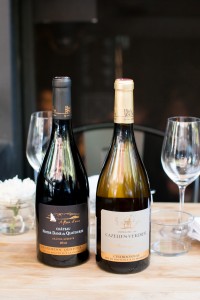
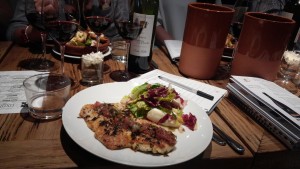
A tarte au citron (lemon tart) and a tarte au chocolat (chocolate tart) provided a welcome citrus and sweet ending to a fine food and wine pairing experience. A Chateau de Jonquieres, Cuvee Eole, 2014 blend of Syrah and Grenache from Val d Orbieu in Narbonne, with delicate raspberry and subtle oak aromas, and ripe berry and lively spice notes balanced the citrus elements of the lemon tart while enhancing the rich and slightly bitter flavors of the chocolate tart.
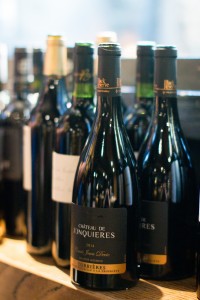
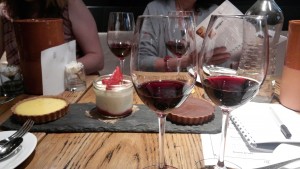


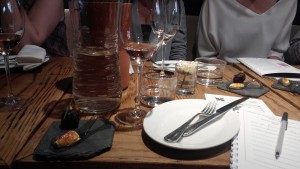







Dear Michelle,
Thank you for this great , very well written article.
We had a such a great time with you that day!
Looking forward to catching up with you soon,
Best wishes,
Olivier
Hi Olivier,
It was my pleasure and I am glad you liked the article. I hope to catch up with you soon as well!
Michelle